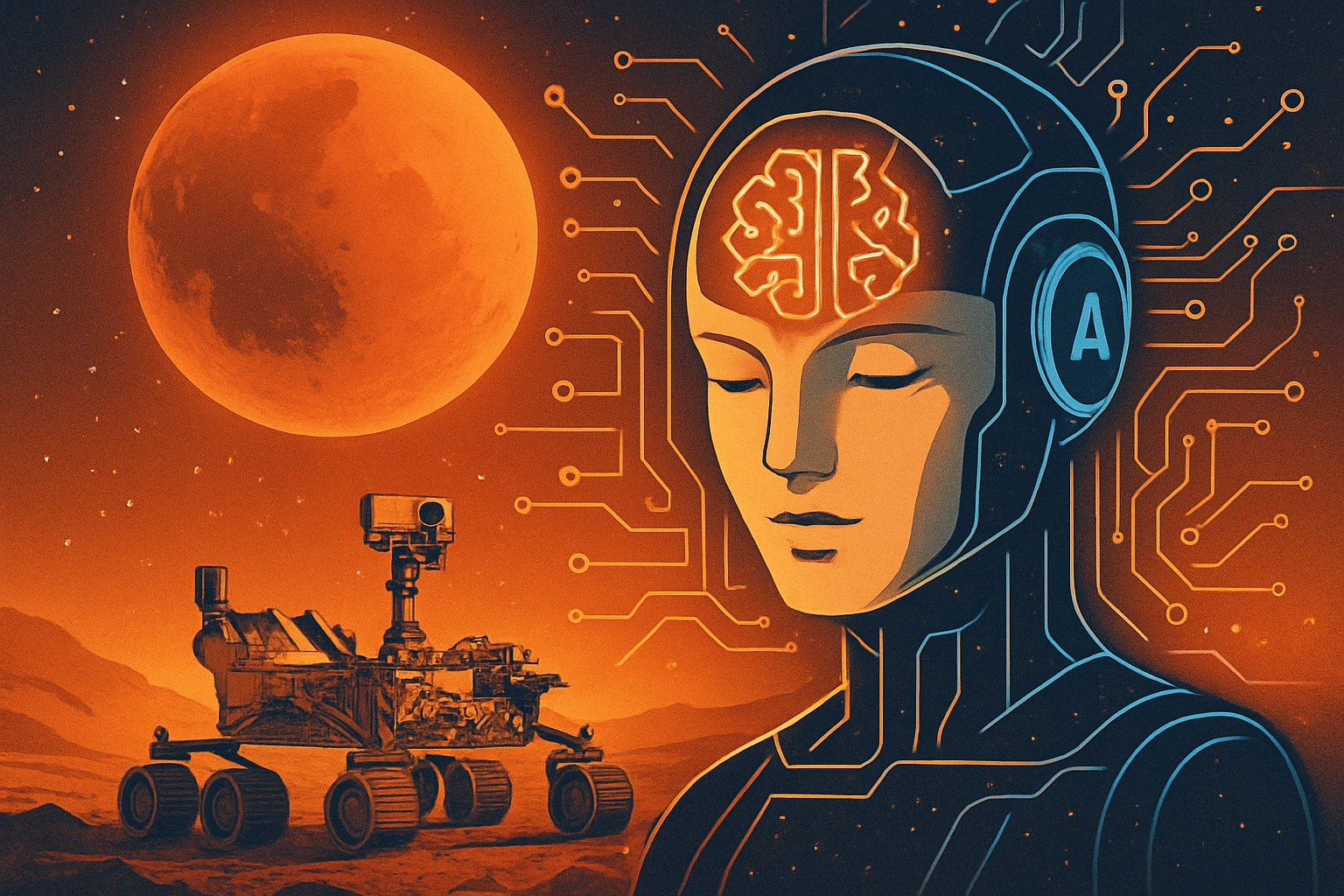
AI: The Unseen Power Behind Mars Dreams
Did you know NASA’s Curiosity Rover can make decisions on its own — without waiting hours for commands from Earth? Yup. That little rolling science lab has some serious brains, thanks to onboard AI. And that’s not just cool — it’s game-changing when you think about how far away Mars actually is. (Spoiler: very, very far.)
Let’s get real here for a second — we’ve all dreamt of space, right? Floating in zero gravity, building cities on Mars, sipping coffee while gazing at Saturn’s rings (okay, maybe that’s just me). But when you start looking under the hood of what it actually takes to live on another planet, things get complicated. I mean, Mars isn’t just across the country — it’s a whole planet away. Communication delays of up to 22 minutes, extreme weather, total autonomy… This isn’t your usual long-distance relationship.
Here’s where AI swoops in like a cosmic superhero. Unlike the sci-fi versions we grew up watching (shoutout to HAL 9000), AI in space is more like a brilliant, invisible co-pilot helping us beat the odds. It handles everything from navigating harsh terrain to managing life support systems — all without needing a nap or a snack.
So, how exactly is AI powering our Mars dreams?
- Autonomous navigation: AI helps rovers (and, eventually, humans) safely maneuver the Martian surface. Think of it as Google Maps for Mars — but with way more rocks and danger.
- Smart decision-making: AI systems are already running experiments, spotting geological hot spots, and prioritizing scientific data faster than human crews could.
- Life support automation: In future Martian habitats, AI will monitor oxygen levels, water recycling, and temperature — basically, keeping us alive while we sleep.
I remember geeking out over NASA’s Open MCT (a mission control tool), and learning that it’s open-source and packed with intelligent automation. It’s wild to think tools like that could one day be running your own DIY Mars greenhouse! It makes space feel… personal somehow. Like this crazy dream of interplanetary living isn’t just for astronauts anymore — it’s for tinkerers, coders, makers. Us.
And here’s a stat that blew my mind: According to ESA’s estimates, future space missions could rely on up to 90% autonomous operations due to the delays in communication. That’s not just convenient, that’s essential for survival off-Earth. In other words, if we ever hope to plant that first human footprint on Mars and actually stay long enough to build something, AI isn’t optional — it’s the only way.
So what’s the bottom line? If you’ve ever dreamed of living on Mars (or at least controlling a mission from your laptop), AI is your backstage pass. It’s the engine quietly running behind the curtain, turning wild sci-fi visions into grounded (or should we say off-world) reality.
We’re not just watching rockets blast off anymore. We’re coding them, guiding them, and making real decisions about how humanity survives — and thrives — beyond Earth. And AI? It’s not the future. It’s the fuel.
So, ready to explore how AI is making Mars feel a little closer to home? Let’s dive in — this is just the beginning.
Navigating Mars: AI’s Essential Guidance
Did you know that there’s no GPS on Mars? That’s right — our trusty satellite-based navigation system that helps us avoid getting lost on Earth is non-existent on the Red Planet. So how do we help our robotic explorers find their way around rocky hills, dusty dunes, and deep ravines, all from millions of miles away?
Well, that’s where AI steps in like a cosmic co-pilot.
The Martian Landscape: Beautiful but Brutal
Imagine trying to drive through a desert you’ve never been to, blindfolded, with only a delayed voice in your ear telling you where to go. That’s kind of what it’s like for rovers on Mars. The terrain is unpredictable — think steep cliffs, soft sand traps, jagged rocks, and the occasional dust devil. And with a delay of up to 22 minutes in radio signals between Earth and Mars, real-time remote control? Not an option.
The stakes are high. One wrong move, and a rover — a billion-dollar piece of tech — could get stuck in soft soil or take a deadly tumble down a crater.
AI: Mars Rovers’ Smartest Travel Companion
This is where artificial intelligence becomes more than a buzzword — it becomes brainpower. AI powers autonomous navigation systems, allowing Mars rovers to “see,” think, and decide where to move next without micromanagement from Earth. Using a combo of machine learning, pattern recognition, and real-time data crunching, AI helps rovers read the terrain and chart the safest path forward.
Take NASA’s Perseverance for example. It’s equipped with a brilliant AI-based navigation system called AutoNav. This system lets it process images from its own cameras, assess hazards, and steer — all by itself. A human would take hours to plan a route. Perseverance? It handles it in minutes while rolling along.
Stories from the Surface
These AI-powered missions aren’t just theory — they’re out there making history. Remember Curiosity? Launched way back, it began with limited autonomy but gradually got smarter updates that allowed partial self-driving, helping it avoid being trapped (like its unlucky cousin, Spirit, which got stuck in sand back in the day).
Perseverance is going even further. In one instance, it used AutoNav to drive a record-breaking 109 meters in a single Martian day — solo. No human intervention, no joystick from NASA. Just pure self-confidence backed by machine learning.
How We Make It Happen: Integrating AI Into Navigation
If you’re geeking out over how this all works (no judgment — same here!), here are a few practical steps scientists are taking to blend AI with Martian navigation:
- Terrain mapping: Feed AI tons of satellite and rover imagery to teach it what Martian surfaces look like — from safe flatlands to dangerous ridges.
- Obstacle detection algorithms: Build systems that help identify hazards in real-time using stereo cameras and LIDAR scanners onboard the rover.
- Neural networks for pathfinding: These systems act like a rover’s “gut instinct” — predicting the safest and most fuel-efficient path, like a hiker analyzing a trail.
If it sounds a bit like training a Mars-savvy self-driving car, you’re not wrong. The technology is surprisingly similar — just with higher risks and no repair shops out there.
The Promise of the Path Ahead
Here’s the big takeaway: AI isn’t just helping us survive on Mars — it’s helping us thrive out there. Each self-navigated journey brings us one step closer to humans inhabiting the Red Planet. And the more we refine these systems, the better our chances of eventually calling Mars home.
So next time you use GPS on your phone to find a taco place two blocks away, just think — our rovers are doing something 100 times harder, with zero signal, in a landscape that’s basically a dusty alien jungle. And they’re crushing it. That’s the magic of AI.
Life Support Systems: AI Optimizes Survival
Did you know? A human can survive just three minutes without oxygen, but on Mars, you could run out of breathable air—and options—even faster. 😳 Kinda terrifying, right?
When you think about living on Mars, your mind probably jumps to the big stuff: building space stations, growing food in red dust, jet-packing around like a sci-fi hero. But here’s the real kicker—something as basic as breathing, staying warm, or sipping clean water becomes a full-blown engineering miracle on the Red Planet.
See, Mars isn’t exactly what you’d call “move-in ready.” We’re talking bone-dry landscapes, wild temperature swings from cozy to cryogenic, and an atmosphere that’s 95% carbon dioxide. No breathable air, zero natural protection against radiation, and almost no water. So maintaining a human-friendly habitat up there? Not optional. It’s everything.
So How Do We Make Life Possible… Reliably?
The answer—surprise, surprise—is AI. Artificial Intelligence is the quiet hero that could literally keep us alive in space. I’m not talking about Wall-E rolling around serving you snacks (though, yes please), but sophisticated algorithms that monitor, adjust, and anticipate the needs of human habitats, 24/7.
Here’s how AI jumps in to save the day (and your lungs):
- Environmental Monitoring: AI constantly tracks levels of oxygen, carbon dioxide, humidity, and temperature. It doesn’t just report—it adjusts. If oxygen starts dipping, it kicks in oxygen generators. If humidity spikes, hello dehumidifier mode.
- Water Recycling: Every drop counts on Mars. AI helps run efficient closed-loop water systems, filtering and reusing moisture from the air and even… yep, human waste. (Don’t think about it too hard.)
- Energy Management: Solar panels are great until a dust storm rolls in. AI optimizes when and how we use energy, storing it or rationing it based on forecasts and usage patterns. Smart, huh?
Real-World Examples Already Making it Happen
You know what’s cool? We’re not starting from scratch. The International Space Station (ISS) already uses AI-assisted life support systems that monitor gas levels and recycle water. And NASA’s Environmental Control and Life Support System (ECLSS) uses advanced software to manage everything from air composition to thermal control. Basically, Earth’s orbit is our test lab.
Plus, companies like AI SpaceFactory and LifeShip are developing smart, self-sustaining habitats that combine AI with biospheres to support long-term space living. AI will soon know when to plant lettuce, when you need a nap, and how much ice to melt for tomorrow’s drinking water.
So, Can We Really Trust AI with Our Lives on Mars?
Honestly? We have to. But I’ve found that when machines do what they’re designed for—factoring in hundreds of data points a second, making decisions faster than we ever could—they’re pretty reliable caretakers. Especially when failure’s not an option.
What’s exciting is that every life support breakthrough we build with AI doesn’t just get us closer to surviving on Mars—it pushes the boundaries for how we live sustainably on Earth too. Mars isn’t just some dusty backup plan. It’s becoming a drive to innovate.
So here’s the takeaway: AI won’t just help us survive. With the right tech and a little human heart, it’s going to help us thrive—even 140 million miles from home. Let’s breathe easy, friends. The future is looking pretty breathable. 🚀
AI in Communication: Bridging Earth and Mars
Ever tried texting someone and had them reply *five hours later*? Frustrating, right? Now imagine sending a message to your buddy on Mars—and waiting up to **22 minutes** just for it to arrive. That’s not even counting the reply time. It’s like trying to have a conversation through smoke signals across an ocean. Wild.
This crazy time lag is a real pain point in the dream of a Mars colony. You can’t just pick up a cosmic phone and check in with mission control when you run into an emergency—or, let’s be honest, when your coffee machine breaks…
The Delay Dilemma: Light-Speed Just Isn’t Fast Enough
Here’s the core of the issue: Mars is, on average, 140 million miles from Earth. And even though light (and radio signals) travel fast, we’re talking about a **3 to 22 minute delay each way**, depending on where the two planets are in their orbits. That’s a loooong wait if you’re in trouble during a mission or trying to coordinate robotics remotely.
It’s not just annoying; it’s dangerous. Think about autonomous systems trying to land or navigate without instant, real-time feedback. That’s where AI struts in like the hero in a space movie—ready to save the day when Earth’s out of reach.
How AI Keeps the Conversation Flowing Across Space
AI doesn’t magically remove the distance (sadly, still no warp drive), but it does make communication smoother and smarter. Here’s how:
- Autonomous Decision-Making: AI onboard spacecrafts can act as mission control’s local rep—handling issues in real time, making judgment calls, and reducing the need for back-and-forth check-ins.
- Natural Language Processing (NLP): No more sending clunky code. NLP lets humans talk to AI systems in plain language for ease and speed—think “Siri, adjust solar panels to 45 degrees.”
- Data Compression and Prioritization: AI can compress massive data streams and prioritize crucial messages so that what really matters gets delivered first.
I remember reading about NASA’s use of AI for the Mars Rovers, where the systems could decide which rocks looked scientifically juicy enough to examine—without having to wait for Earth to RSVP. That’s a game changer, especially when every minute counts (and every byte of data costs).
Bringing AI into Space Comms: What Needs to Happen
If we’re serious about sending humans to Mars and beyond, we need to get intentional about integrating AI into space communication systems. Here’s what that looks like in practical steps:
- Design Onboard Intelligence: Build spacecraft with smart processors that can analyze data and make decisions locally, even while offline.
- Train AI on Space Scenarios: Feed AI models data from past missions so they’re prepped for anomalies, system faults, and Martian mood swings.
- Develop Interplanetary Internet: We’re not talking broadband speeds just yet, but AI-managed networks (looking at you, DTN—Delay Tolerant Networking) can maintain stable connections despite cosmic hiccups.
And yes, even SpaceX and NASA are actively exploring AI-driven networks to keep future astronauts chatting safely with home base—even if it’s just to share jokes and rover selfies (hey, mental health matters).
Space Chat 2.0: We’re Closer Than You Think
It might sound like science fiction, but AI is quietly becoming the invisible glue that could hold our interplanetary conversations together. With each new Mars mission, each satellite upgrade, we’re inching closer to truly autonomous communication systems—ones that won’t leave astronauts hanging mid-convo.
So next time you’re annoyed by a late text, remember—you could be waiting eight minutes on Mars just to say, “Can you hear me now?” But with a little AI on our side, the answer might just come faster than you’d think.
Building Infrastructure: AI Constructs Our Future
Here’s a wild stat to chew on: a single cargo shipment to Mars could cost upwards of $500,000 per kilogram. Yup, that’s the kind of cash we’re dealing with when shipping even a hammer to the Red Planet. So, building homes, labs, and greenhouses up there? It’s not just tricky — it’s borderline impossible without some serious ingenuity. And that’s where AI steps in as our cosmic construction manager.
Why Building on Mars Is Way Harder Than You Think
Picture this — you’re trying to assemble a habitable base in a place where dust storms rage for weeks, temperatures drop to -125°C, and oxygen isn’t exactly flowing. Oh, and did I mention the lack of human hands-on help? Everything has to be set up (and survive) long before we even arrive. Traditional construction methods? Not gonna cut it on a planet 54.6 million kilometers away.
That’s where I get super jazzed about AI. It’s not just a helpful assistant; it’s the only “employee” we can send ahead to do the heavy lifting — quite literally. Automated systems powered by AI can survey terrain, design layouts based on real-time data, and coordinate fleets of robotic builders. It’s like SimCity, but for real. And on Mars.
How AI Is Already Building the Martian Dream
AI is already flexing its muscles in this space (pun intended). Here’s how:
- Autonomous Rovers & Drones: Tools like NASA’s Perseverance rover already use AI to navigate and analyze terrain. This groundwork is critical for future construction planning.
- 3D Printing Robots: Projects like SEArch+ and Apis Cor are developing AI-assisted 3D printers that can use Martian regolith (the local dirt!) to print structures. Talk about resourcefulness.
- Swarm Robotics: Think multiple small robots working together, like ants building a colony. That’s being tested here on Earth for Mars application.
I remember geeking out over a case study where AI-designed structures were not just space-efficient—they could also self-regulate temperature using data from environmental sensors. That’s some next-level smart-home stuff. On Mars. Incredible.
Your AI-Ready Blueprint for Martian Construction
Want to imagine this yourself or even build toward it? Here’s how we start:
- Learn from Earth-bound labs: Projects like the Mars Habitat Challenge by NASA give us validated models for AI construction. Dive into their findings—it’s an absolute goldmine of knowledge.
- Embrace modularity: AI thrives in repeatable patterns. Designing modular, scalable pieces that AI can replicate simplifies construction and increases success rates.
- Train AI with simulation data: Earth-based Martian analog environments (like deserts or Icelandic landscapes) are great training grounds. Companies are simulating Martian conditions and training AI systems on them already.
Looking Forward to a Self-Built Martian Future
We’re not sending bulldozers to Mars — we’re sending brains. Smarter construction powered by AI isn’t science fiction anymore — it’s shaping up to be our reality. Pretty soon, we’ll have habitats built before we ever land. And what’s cooler than arriving at your new Martian home where the robot butlers built everything while you were still on Earth sipping coffee?
This is what makes space exploration so thrilling — we’re literally building dreams, and AI is holding the blueprint. Let’s keep imagining, and more importantly, keep building.
AI: Empowering Humanity’s Next Giant Leap
Did you know? NASA’s Mars rovers rely on onboard AI to make real-time decisions—like choosing which rocks are most interesting to analyze—all without asking home base. That’s literally thinking on another planet.
Now, think about this: if AI can already survive—and even thrive—amidst the dust storms and radio delays of Mars, what else can it do to make living there a reality?
Let’s be real: dreaming of a home on Mars sounds like something out of a sci-fi movie (cue dramatic music and red planet panoramas). But here’s the catch: the challenges aren’t just about rockets and space suits. We’re talking food, shelter, clean air, human health, communication, even boredom. And surprise, surprise—AI is stepping up as our trusty co-pilot in all of it.
I’ve always been that person binge-watching space documentaries at 2 AM, whispering “someday.” Same for you? Now, suddenly, “someday” feels a whole lot closer. And it’s all because AI isn’t just crunching data—it’s amplifying our potential.
So, how do we let AI help us pack our bags for Mars?
- Autonomous Farming: AI can manage hydroponic or even Martian soil-based crops, adjusting nutrients and water based on real-time plant data. No green thumb required—just green code.
- Predictive Maintenance: On Mars, if a system fails, it can be life-threatening. AI models can predict part failures before they happen, so your oxygen doesn’t run out mid-nap.
- Smart Life Support: AI can balance CO₂, temperature, and radiation shielding in habitats—so humans can focus on exploration and, y’know, not dying.
Take this example: researchers recently used AI to design a prototype Martian habitat. The system optimized materials, structure, and location—all while considering the harsh Martian environment. It shaved months (and maybe millions) off the planning timeline. Isn’t that wild?
What does this mean for you and me? Whether you’re an astronaut hopeful, a tech geek, or just love staring up at stars with wide eyes, this is the moment to lean in. You don’t need a space suit to be part of the mission. You can contribute as a coder, a data scientist, a systems thinker—or simply by staying curious and informed.
The dream of becoming a multi-planetary species is no longer sci-fi. It’s science…with AI. And honestly? That’s thrilling.
So here’s the final boarding call: Are you ready to be part of the story? Humanity’s next giant leap isn’t on the Moon—it’s on Mars. And with AI as our guide, we might just get there faster than we dared to hope.
Let’s build the future together—one algorithm, one innovation, and one red dusty footprint at a time.












